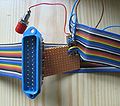Difference between revisions of "Test Circuit used for ACID reverse engineering"
From CPCWiki - THE Amstrad CPC encyclopedia!
| Line 35: | Line 35: | ||
When I came back home, I wrecked the original circuit, and made a miniaturized adapter with robust centronics socket. Not that I'd still really needed it - I've been already done with the rev engineering at that time - I just don't like messy cables. | When I came back home, I wrecked the original circuit, and made a miniaturized adapter with robust centronics socket. Not that I'd still really needed it - I've been already done with the rev engineering at that time - I just don't like messy cables. | ||
| − | [[Category: | + | [[Category:CPC Plus]][[Category:Cartridges| ]][[Category:DIY]] |
[[Category:CPC History]] | [[Category:CPC History]] | ||
Latest revision as of 17:07, 19 December 2010
ACID Reverse Engineering
Schematic
Desoldered ACID chip from Fano's cartridge (thanks, Fano), attached to PC's parallel printer port:
ACID PC CLK ---- Strobe CCLR ---- Init SIN ---- Busy /OE ---- Select A0..A7 ---- Data 0..7 GND,5V ---- GND,5V
Source Code
For curiosity, here's the original source code used for reverse-engineering. It's barely commented or user-friendly.
Pictures
- Original messy circuit
This is original circuit, assembled while I was visiting my parents. I couldn't find a 36pin centronics socket, only a (very) old 25pin RS232 cable, so I needed to use that.
- Newer clean circuit
When I came back home, I wrecked the original circuit, and made a miniaturized adapter with robust centronics socket. Not that I'd still really needed it - I've been already done with the rev engineering at that time - I just don't like messy cables.





